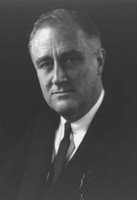 More fun with sparse data
More fun with sparse dataPolitical pundit William Safire defined “thumbsucker” in Safire's Political Dictionary as a “political reporter's term for an analytical story; a think piece.” He adds that “Reporters and editors use the term with derision, to mean the opposite of ‘well researched.’”
A thumbsucker on political second chances by Margaret Talev of the Washington Bureau of McClatchy News has been popping up in various newspapers the last couple of months. It is clearly a thumbsucker in the first sense of Safire's definition, a discourse on the mixed record of politicians' second tries for the White House. While I would not go so far as to call it a thumbsucker in Safire's second sense—the information it contains is accurate—the article nevertheless fails to make a good case for its main argument. Talev describes the current positions of Kerry, Edwards, and Gore as active or potential future candidates for president.
But if any of these men goes ahead with a comeback campaign, history is stacked against him.I think we get the point. As the Raleigh News & Observer said in its headline when it published Talev's piece on April 24, 2006, “2nd time's no charm for failed nominees.” When the Sacramento Bee picked up the article on June 4, 2006, it ran a blunt subhead: “History doesn't favor a comeback by Democrats Kerry, Edwards or Gore.” Take that, you guys!
In three cases since the Civil War era, a presidential or vice-presidential nominee on a losing Democratic or Republican ticket was able to win the presidency in a subsequent election: Grover Cleveland, Franklin D. Roosevelt and Richard Nixon.
The list of those who tried but failed is considerably longer.
 Let us turn our attention now to the “considerably longer” list of second-time losers:
Let us turn our attention now to the “considerably longer” list of second-time losers: William Jennings Bryan, Thomas Dewey, Adlai Stevenson, Walter Mondale and Bob Dole each won another nomination after a loss, but none succeeded in the general election. Bryan was a three-time loser. Others who made the ticket and lost were unable to secure their party's nomination when they ran again: Ed Muskie, Dan Quayle and Joe Lieberman.Well, that's definitely a longer list. I guess that clinches the argument.
Or does it?
Let's take a second look at the list of rerun losers. The original list of losers included Bryan, Dewey, Stevenson, Mondale, and Dole. That's five people who were on national tickets at least twice and lost both times. But then Talev padded out the list of losers with one-timers Muskie, Quayle, and Lieberman. That sure makes the list of losers longer, but only at the cost of changing the criterion. This second group of losers never got a second nomination.
 In summary, there were three candidates who lost national elections as nominees for president or vice president and came back to win the White House. There were five candidates who lost national elections as nominees for president or vice president who came back to lose a second race (and in Bryan's case a third) as a presidential nominee. Three versus five. You know, I don't see that the historical deck is that heavily stacked against repeats. Three chances out of eight is 37.5%, which is by no means a trivial probability.
In summary, there were three candidates who lost national elections as nominees for president or vice president and came back to win the White House. There were five candidates who lost national elections as nominees for president or vice president who came back to lose a second race (and in Bryan's case a third) as a presidential nominee. Three versus five. You know, I don't see that the historical deck is that heavily stacked against repeats. Three chances out of eight is 37.5%, which is by no means a trivial probability.Whenever you try to spin out a theory based on such a small data set, you can be certain to find all sorts of interesting things. They just won't be significant. There have been too few presidential campaigns to offer us more than a tiny subset of the combinations and outcomes that might establish trends in the longer term. Why didn't Talev use the cases of Kennedy and Kerry to argue that a Catholic from Massachusetts can be elected president only if he is young and devilishly handsome? That might have been too transparent.
I imagine in the future, after we've had a couple of female presidents, there'll be articles trying to deduce general principles from a sample of size two. The two-time loser theory is not quite as trivially speculative, but it's close. As a historical piece, the Talev article is informative and interesting. As an analytic piece, its value is negligible. In that sense, a thumbsucker.
Note: The title of this post is a parody of the law of large numbers, a probability theorem that says the mean of a large sample taken from a population will generally be close to the mean of the whole population. Click on the link for more, if you're curious. Different meanings have also been assigned to the law of small numbers, some of them jocular.












1 comment:
eProf22 had some difficulties with Blogger while trying to post a comment, so he sent it directly to me via e-mail. Thanks for the kind words, eProf! His remarks follow:
I tried to send a comment on your post this morning but to no avail. I really thought your post on "the law of small numbers" was excellent. Stat teachers everywhere should use it as an intro essay. Maybe, political science instructors should use it too. Ah, hell, everyone should read it. It makes you wonder how many headlines are misused and misstated like the one in the Bee. Well done!
I hope you don't mind but I've put a link to your blog on my blog now that it's open again.
Post a Comment